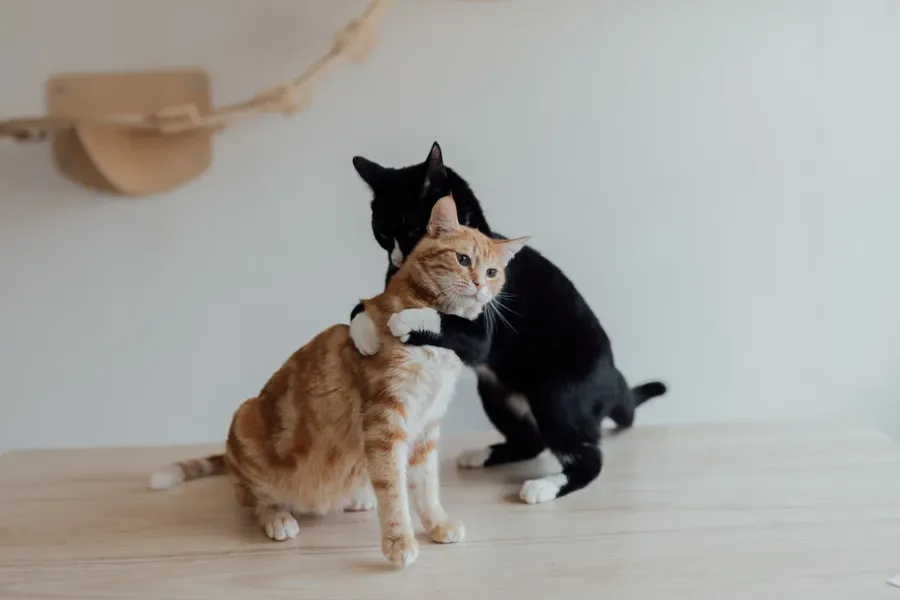Is It Better To Have Two Cats Of The Same Gender

Published by: Tatsiana Korshik
Time to Read: 3 Min

Adding a new feline companion to your household is an exciting decision, but one that comes with considerations about dynamics and relationships between cats. One question that often arises is whether it's better to have two cats of the same gender. In this comprehensive guide, we'll delve into the intricacies of feline relationships, discussing the compatibility of female-female, male-male, and male-female pairings. By the end, you'll have a better understanding of how to choose the right companion for your existing cat and create a harmonious multi-cat household.
Personality Match: Aim for a complementary personality. If your resident cat is playful, an equally playful companion might be a good fit.
Age Consideration: Cats of similar ages might find common ground faster. Kittens generally adapt more easily to new companions.
Socialization History: Cats with positive experiences with other cats in their past are often more open to new relationships.
Health and Neutering Status: Ensure the new cat is in good health and spayed/neutered to reduce potential conflicts.
Gradual Introduction: Implement a gradual introduction process, using scent exchange and controlled interactions.
Conclusion
The decision to have two cats of the same gender depends on various factors, including the cats' personalities, their past experiences, and your household dynamics. Female-female, male-male, and male-female pairings can all work harmoniously with proper introductions and management. Understanding your cats' needs, personalities, and the gradual introduction process is key to cultivating a positive and lasting feline companionship. By making informed decisions and dedicating time to a successful introduction, you're paving the way for a fulfilling and joyful multi-cat household that benefits both your cats and your own well-being.
Can Female Cats Live With Other Female Cats?
Female cats, also known as queens, have diverse personalities that impact their compatibility. Generally, female-female pairings can work well when introductions are managed carefully. Early exposure to other cats during kittenhood might make female cats more open to forming strong bonds, while older females may require more time to adjust. Supervised introductions, separate resources, and gradual cohabitation can help prevent territorial conflicts.Can Male Cats Live With Other Male Cats?
Male cats, or toms, can form deep bonds with other males if introduced early in life or raised together as littermates. However, some adult male cats can exhibit territorial behaviors and may not tolerate other males in their space. Neutering can mitigate aggressive tendencies, making male-male pairs more harmonious. Controlled introductions and proper resource management are key to successful cohabitation.Can a Male Cat and a Female Cat Live Together?
A mixed-gender pairing is possible and can lead to strong friendships, particularly if the cats are spayed/neutered. A neutered male and a spayed female are less likely to engage in territorial disputes and aggression. However, ensure the timing of spaying/neutering aligns to avoid potential behavioral conflicts. The initial introduction process and careful monitoring are crucial for a successful mixed-gender pair.How to Pick a New Cat
When selecting a new cat to introduce to your existing cat, consider the following factors:Personality Match: Aim for a complementary personality. If your resident cat is playful, an equally playful companion might be a good fit.
Age Consideration: Cats of similar ages might find common ground faster. Kittens generally adapt more easily to new companions.
Socialization History: Cats with positive experiences with other cats in their past are often more open to new relationships.
Health and Neutering Status: Ensure the new cat is in good health and spayed/neutered to reduce potential conflicts.
Gradual Introduction: Implement a gradual introduction process, using scent exchange and controlled interactions.
Conclusion
The decision to have two cats of the same gender depends on various factors, including the cats' personalities, their past experiences, and your household dynamics. Female-female, male-male, and male-female pairings can all work harmoniously with proper introductions and management. Understanding your cats' needs, personalities, and the gradual introduction process is key to cultivating a positive and lasting feline companionship. By making informed decisions and dedicating time to a successful introduction, you're paving the way for a fulfilling and joyful multi-cat household that benefits both your cats and your own well-being.



